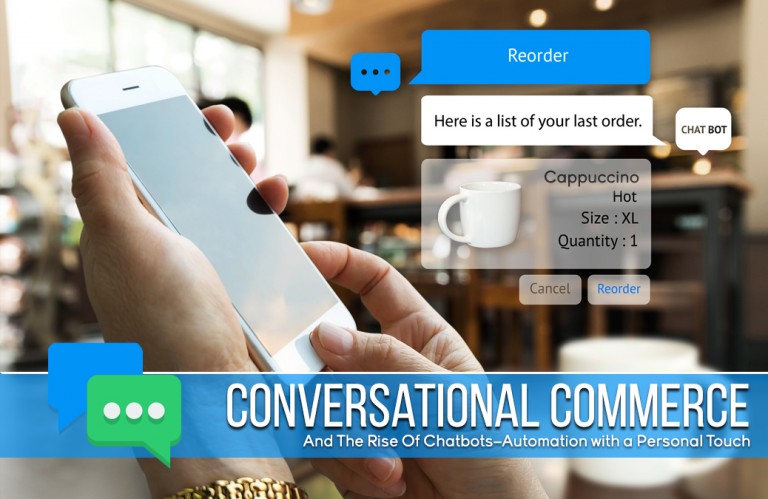

While mobile devices have always served as tools for communication, the way we interact with these devices is quickly changing. Personal calls and texts are commonplace activities but more and more, online time is spent in communication between consumers and retailers. Increasingly, new tools are allowing brands to communicate with customers through mobile devices in new, innovative and personalized ways.
The idea of conversational commerce, coined by Uber’s Chris Messina, speaks to this growing trend of communication between businesses
and consumers through messaging apps. Rather than just clicking through pages on a website or emailing and calling companies to get information, users can now communicate with businesses instantly and in real-time through chatbots (automated chat agents), for a more personalized and conversational experience.


The explosion of online mobile device use in recent years has forced businesses to reinvent how they engage consumers; mobile devices accounted for almost 2 in 3 minutes spent online in December 2015, and more adults accessed the internet via mobile only than desktop only. While most adults still use both platforms, one in five Millennials (18-34) are mobile-only. With this move to mobile, messaging apps like WeChat, WhatsApp and Facebook Messenger have become the go-to for communication on mobile phones. Thanks to advances in artificial intelligence, we can easily converse with chatbots (automated chat agents) in our messaging apps, much like we would any other contact. They can assist with everything from online shopping, to calling a cab and order food for delivery. We also interact with digital assistants like Apple’s Siri, Google’s Now, Microsoft’s Cortana and Amazon’s Alexa. Essentially, consumers are getting used to talking to machines
A big reason chatbots are increasingly popular, is the fact that people are tired of downloading an app for everything. With the exploding popularity of messenger apps, an alternative to creating yet another new app is to offer your service inside an app they already have. Sites like Facebook, WhatsApp and Twitter are introducing integrated bots to help with shopping, booking and customer service. These chatbots will answer customer questions and serve as a first point of contact for a brand, through text or even voice.
While chatbots offer a solution for ecommerce business owners to manage a high volume of one-to-one conversations, there are risks. Bots can lack personality and conversational flow, and often can’t deviate from a programmed script. Also, when a bot launch goes wrong, it can be pretty embarrassing, like Microsoft’s chatbot Tay on Twitter. Many retailers are experimenting with a mix of live support staff and automation for customer service, sales support and other commerce-related functions. Chatbots are intended to improve the user experience, not replace real people, and the right mix can make all the difference.


Ecommerce is becoming increasingly integrated into our lives in a more personalized and conversational way. Businesses are creating new and innovative touch points to reach consumers and sell their brand. With the amount of time consumers spend on mobile devices every day and the huge popularity of messagin



